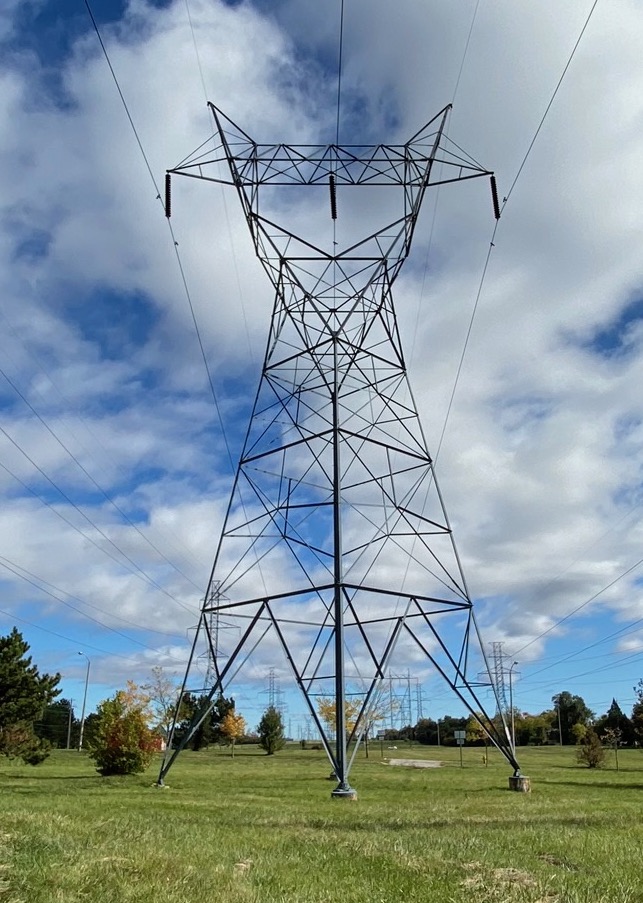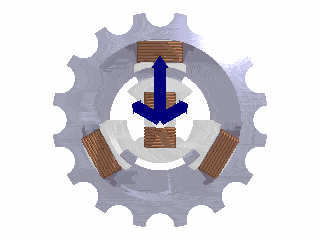|
Transposition Tower
In electrical power transmission, a transposition tower is a transmission tower that changes the relative physical positions of the conductors of a transmission line in a Polyphase system. A transposition tower allows these sections to be connected together, while maintaining adequate clearance for the conductors. This is important since it distributes electrical impedances between phases of a circuit over time, reducing the problem of one conductor carrying more current than others. Double-circuit lines are usually set up with conductors of the same phase placed opposite each other. This reduces the reactance due to mutual inductance; the reactance of both circuits together is less than half that of one circuit. For example, a section of a line may be (top-to-bottom) phases A-B-C on the left, also phases C'-B'-A' on the right. The next section may be B-C-A on the left, also A'-C'-B' on the right. Therefore, the rotation on each side of the tower will be opposite. Verdrillmast_Obe ... [...More Info...] [...Related Items...] OR: [Wikipedia] [Google] [Baidu] |
Electrical Power Transmission
Electric power transmission is the bulk movement of electrical energy from a generating site, such as a power plant, to an electrical substation. The interconnected lines that facilitate this movement form a ''transmission network''. This is distinct from the local wiring between high-voltage substations and customers, which is typically referred to as electric power distribution. The combined transmission and distribution network is part of electricity delivery, known as the electrical grid. Efficient long-distance transmission of electric power requires high voltages. This reduces the losses produced by strong currents. Transmission lines use either alternating current (HVAC) or direct current (HVDC). The voltage level is changed with transformers. The voltage is stepped up for transmission, then reduced for local distribution. A wide area synchronous grid, known as an "interconnection" in North America, directly connects generators delivering AC power with the same relativ ... [...More Info...] [...Related Items...] OR: [Wikipedia] [Google] [Baidu] |
Transmission Tower
A transmission tower, also known as an electricity pylon or simply a pylon in British English and as a hydro tower in Canadian English, is a tall structure, usually a steel lattice tower, used to support an overhead power line. In electrical grids, they are generally used to carry high-voltage transmission lines that transport bulk electric power from generating stations to electrical substations; utility poles are used to support lower-voltage subtransmission and distribution lines that transport power from substations to electric customers. They come in a wide variety of shapes and sizes. Typical height ranges from , though the tallest are the towers of a span between the islands Jintang and Cezi in China's Zhejiang province. The longest span of any hydroelectric crossing ever built belongs to Ameralik Span, the powerline crossing of Ameralik fjord with a length of . In addition to steel, other materials may be used, including concrete and wood. There are four major categ ... [...More Info...] [...Related Items...] OR: [Wikipedia] [Google] [Baidu] |
Conductor (power Engineering)
In physics and electrical engineering, a conductor is an object or type of material that allows the flow of charge (electric current) in one or more directions. Materials made of metal are common electrical conductors. Electric current is generated by the flow of negatively charged electrons, positively charged holes, and positive or negative ions in some cases. In order for current to flow within a closed electrical circuit, it is not necessary for one charged particle to travel from the component producing the current (the current source) to those consuming it (the loads). Instead, the charged particle simply needs to nudge its neighbor a finite amount, who will nudge ''its'' neighbor, and on and on until a particle is nudged into the consumer, thus powering it. Essentially what is occurring is a long chain of momentum transfer between mobile charge carriers; the Drude model of conduction describes this process more rigorously. This momentum transfer model makes metal an idea ... [...More Info...] [...Related Items...] OR: [Wikipedia] [Google] [Baidu] |
Transmission Line
In electrical engineering, a transmission line is a specialized cable or other structure designed to conduct electromagnetic waves in a contained manner. The term applies when the conductors are long enough that the wave nature of the transmission must be taken into account. This applies especially to radio-frequency engineering because the short wavelengths mean that wave phenomena arise over very short distances (this can be as short as millimetres depending on frequency). However, the theory of transmission lines was historically developed to explain phenomena on very long telegraph lines, especially submarine telegraph cables. Transmission lines are used for purposes such as connecting radio transmitters and receivers with their antennas (they are then called feed lines or feeders), distributing cable television signals, trunklines routing calls between telephone switching centres, computer network connections and high speed computer data buses. RF engineers commonly ... [...More Info...] [...Related Items...] OR: [Wikipedia] [Google] [Baidu] |
Polyphase System
A polyphase system is a means of distributing alternating-current (AC) electrical power where the power transfer is constant during each electrical cycle. AC phase refers to the phase offset value (in degrees) between AC in multiple conducting wires; ''phases'' may also refer to the corresponding terminals and conductors, as in color codes. Polyphase systems have three or more energized electrical conductors carrying alternating currents with a defined phase between the voltage waves in each conductor; for three-phase voltage, the phase angle is 120° or 2π/3 radians (although early systems used 4 wire two-phase). Polyphase systems are particularly useful for transmitting power to electric motors which rely on alternating current to rotate. The most common example is the three-phase power system used for industrial applications and for power transmission. Compared to a single-phase, two-wire system, a three-phase three-wire system transmits three times as much power for the ... [...More Info...] [...Related Items...] OR: [Wikipedia] [Google] [Baidu] |
Electrical Impedance
In electrical engineering, impedance is the opposition to alternating current presented by the combined effect of resistance and reactance in a circuit. Quantitatively, the impedance of a two-terminal circuit element is the ratio of the complex representation of the sinusoidal voltage between its terminals, to the complex representation of the current flowing through it. In general, it depends upon the frequency of the sinusoidal voltage. Impedance extends the concept of resistance to alternating current (AC) circuits, and possesses both magnitude and phase, unlike resistance, which has only magnitude. Impedance can be represented as a complex number, with the same units as resistance, for which the SI unit is the ohm (). Its symbol is usually , and it may be represented by writing its magnitude and phase in the polar form . However, Cartesian complex number representation is often more powerful for circuit analysis purposes. The notion of impedance is useful for perf ... [...More Info...] [...Related Items...] OR: [Wikipedia] [Google] [Baidu] |
Transposition (telecommunications)
Transposition is the periodic swapping of positions of the conductors of a transmission line, in order to reduce crosstalk and otherwise improve transmission. In telecommunications this applies to balanced pairs whilst in power transmission lines three conductors are periodically transposed. For cables, the swapping is gradual and continuous; that is the two or three conductors are twisted around each other. For communication cables, this is called twisted pair. For overhead power lines or open pair communication lines, the conductors are exchanged at pylons, for example at transposition towers or at utility poles, respectively. The mutual influence of electrical conductors is reduced by transposition. Transposition also equalizes their impedance relative to the ground, thus avoiding one-sided loads in three-phase electric power systems. Transposing is an effective measure for the reduction of inductively linked normal mode interferences. Power lines For longer powerline ... [...More Info...] [...Related Items...] OR: [Wikipedia] [Google] [Baidu] |
Suspension Tower
In an electric power transmission line, a suspension tower is where the conductors are simply suspended from the tower, the mechanical tension being the same on each side. In this case, the tower is supposed to carry a downward force, and a lateral force, but not a longitudinal force. These may have, for each conductor, an insulator string hanging down from the tower, or two strings making a "V" shape. In either case, sometimes several insulator strings are used in parallel to give higher mechanical strength. These are used where a transmission line continues in a straight line, or turns through a small angle. In other cases, a tension tower (C or D Towers) is used. Enztal 110kV Rohrmasten.jpg, Suspension towers of a 110 kV power line in Germany Опора ЛЭП 330кВ.jpg, A suspension tower of a 330 kV powerline in Ukraine Power line 1150 kV.jpg, A suspension tower of a 1150 kV powerline in Russia Жнива України.jpg, A suspension tower of a 35 kV powerline in Uk ... [...More Info...] [...Related Items...] OR: [Wikipedia] [Google] [Baidu] |
Dead-end Tower
A dead-end tower (also anchor tower, anchor pylon) is a fully self-supporting structure used in construction of overhead power lines. A dead-end transmission tower uses horizontal strain insulators at the end of conductors. Dead-end towers may be used at a substation as a transition to a "slack span" entering the equipment, when the circuit changes to a buried cable, when a transmission line changes direction by more than a few degrees, or at intervals along a straight run to limit the extent of a catastrophic collapse. Since dead-end towers require more material and are heavier and costlier than suspension towers, it is uneconomic to build a line with only self-supporting structures.D.G. Fink, H.W. Beaty, ''Standard Handbook for Electrical Engineers Eleventh Edition'', McGraw-Hill, 1978 , pp. 14-80, 14-81 Dead-end towers are used at regular intervals in a long transmission line to limit the cascading tower failures that might occur after a conductor failure. An in-line dead- ... [...More Info...] [...Related Items...] OR: [Wikipedia] [Google] [Baidu] |
Overhead Power Lines
An overhead power line is a structure used in electric power transmission and distribution to transmit electrical energy across large distances. It consists of one or more uninsulated electrical cables (commonly multiples of three for three-phase power) suspended by towers or poles. Since most of the insulation is provided by the surrounding air, overhead power lines are generally the least costly method of power transmission for large quantities of electric energy. Construction Towers for support of the lines are made of wood either grown or laminated, steel or aluminum (either lattice structures or tubular poles), concrete, and occasionally reinforced plastics. The bare wire conductors on the line are generally made of aluminum (either plain or reinforced with steel or composite materials such as carbon and glass fiber), though some copper wires are used in medium-voltage distribution and low-voltage connections to customer premises. A major goal of overhead power line de ... [...More Info...] [...Related Items...] OR: [Wikipedia] [Google] [Baidu] |





